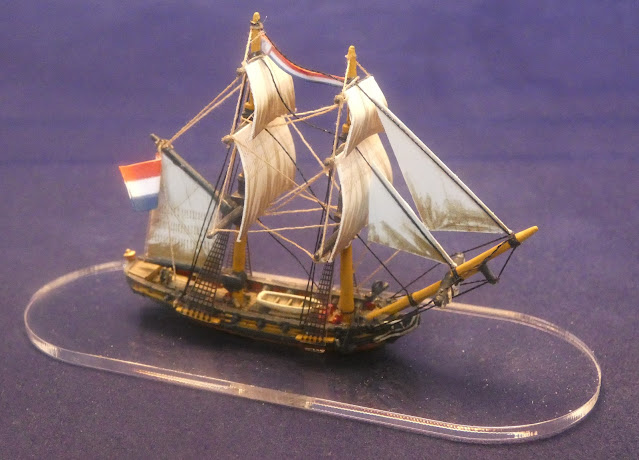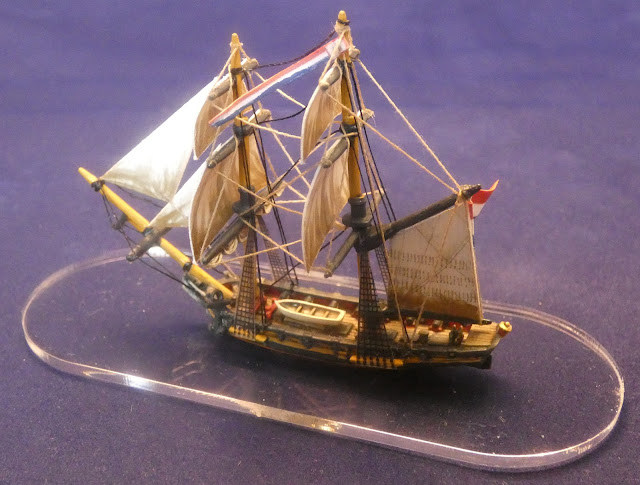It's a really great feeling of satisfaction when a project reaches a conclusion, something I have experienced several times in the lifetime of this blog, be that the building of the Talavera collection, Trafalgar and Cape St Vincent fleets and now the Camperdown collection, properly started back on the 23rd of September with the first post in this series looking at the project build process and the history reflected in the various models
These last six models, the British 16-gun sloop, Martin, and the Batavian-Dutch 16-gun brigs, Galatée, Daphné, Ajax and Atalante and the aviso Het Hassje (the Hare or Rabbit in English) complete the collection of models required to bring the complete Battle of Camperdown to the table in glorious 1:700 scale, and my planner below now shows all the various ships that took part in their respective lines marked up with the white dot of 'doneness'.
These last six models have required a little extra effort and I may come back to them over time and make changes, but for now these are the models that will take the table in the first playing of Camperdown.
The reason for the extra effort were the challenges in finding the right models to represent these actual vessels, with a scarcity of sources in English detailing precisely the look and layout of the Batavians, and a not exact model of a 'Hound-class' sloop or any of these vessels requiring choices to be made as to which models seemed to come closest to catching the look on the table.
 |
| The first-hand illustration of the Battle of Camperdown, with my assumed positioning for the Batavian-Dutch brigs and aviso. |
HMS Martin 16-guns, Hound-class sloop
HMS Martin was a 16-gun Hound-class sloop of the Royal Navy, and served at the Battle of Camperdown in 1797 and captured two privateers before she disappeared in 1800.
The model being used here is the 3-D print from Turner Miniatures of a Swan-class sloop, produced by Only Games, with masts and sails from the Warlord brig, the Swan class being of a similar size, 300 tons, layout and armament to the Hound-class.
Martin was built to a design by John Henslow and ordered from Woolwich Dockyard on the 17th January 1788. Master Shipwright John Nelson worked on her until August 1790, after which William Rule completed her.
Her general characteristics were:
Tons burthen 320 89/94 tons (bm)
Length of gundeck 100 feet
Beam 27 feet
Draught 13 feet
Her armament consisted of:
Upper Gundeck: 16 x 6-pounder long guns.
Quarterdeck and Forecastle, QD: 4 x 12-pounder carronades and Fc: 2 x 12-pounder carronades
She was launched on 8 October 1790 and commissioned on 13 January 1791, having cost a total of £8,732 to build, with a further £1,674 spent on fitting out.
Martin's first commander was George Duff, who would go on to command HMS Mars at Trafalgar, where he was killed in 1805, under whom she sailed off the East coast of Scotland. On 17th March 1792, in the Firth of Forth, the brig Paisley ran into Hales Castle, which sank. Paisley rescued three of Hales Castle's six crew and Martin rescued the other three.
Commander William Lobb took over Martin in April 1795, during which time she served as a Royal escort for Princess Caroline of Brunswick. On 10th December 1795 under her new commander, Samuel Sutton, Martin departed Britain for the West coast of Africa, followed by a voyage to Jamaica.
While Martin was in the North Sea she also transported the Duc d'Angoulême, the future Charles X of France, from Leith to Cuxhaven, and on 27th June Sutton's service brought him promotion to post-captain.
Martin immediately came under the command of Charles Paget, under whom she was present at the Battle of Camperdown on 11th October 1797 serving as a signal repeater for the starboard, or weather division under Admiral Adam Duncan, who was also the overall commander.
Martin disappeared without trace and with all hands in the North Sea in October 1800, and she is presumed to have foundered in heavy seas.
Batavian-Dutch Aviso - Het Hassje
The other vessel is also named Hassje, also brig-rigged, with no details on her size, or when built or taken into service, but that she was also captured by the British in 1803 and entered service with the Royal Navy in 1804 as the fireship HMS Phosphorus.
This model is a bit of a mash-up, using the 3-D hull of the schooner Pickle from Turner Miniatures and Only Games and Warlord Brig masts to produce a 'Snow' like rigged vessel, likely acquired, as some sources suggest, from the VOC, (Dutch East Indies Company) for naval duties.
The only sources I've found for this vessel are for the Hassje, brig rigged and built in 1788 for the VOC of about 160-180 tons bm, but captured by a British whaler in August 1797, recaptured by a French privateer on her way to the UK and later taken back by the British, so it seems unlikely to be our Hassje.
Either way, the first hand illustration of the opening of the Battle of Camperdown (see above), shows five Batavian Dutch brig-rigged vessels in the second line, four of which must be the brigs known to have been present and with the ship-rigged small ships accounted for by the two fifth and two sixth-raters, hence my decision to portray the Het Hassje as seen with a VOC look about her with her white hull paint job.
Point to note, the anchors are the 3-D print option from Only Games, using the smallest prints which with a bit of clipping seem to work really well with the small ship models.
At the Battle of Camperdown Het Hassje was under the command of Liutenant ter Zee Harteveld.
Batavian-Dutch 16-gun brigs, Galatée, Daphné, Ajax and Atalante
And finally, I present the four new Batavian-Dutch brigs, Galatée, Daphné, Ajax and Atalante, using the 3-D printed hulls from Turner Miniatures and Only Games of the French Curieux-class 16-gun brig married with Warlord brig masts and sails.In the first incarnation, my Batavian-Dutch brigs were going to use the Warlord flush deck cruiser class type they have as their generic offered model brig, as seen below in our playthrough of the attack of the Leeward Division at Camperdown earlier this year using Far Distant Ships.
The Warlord models are a nice generic option for a brig and will still be in the Batavian fleet to represent their later larger 18-gun options, but on seeing the model of the 16-gun Atalante, held by the Dutch Maritime Museum in Amsterdam illustrating the classic small poop deck covering the small commander's cabin in the stern, I set about looking for a similar model to capture this look.I am really pleased with the Curieux brig and its similarity to the model seen above, right down to that poop and with not much to go on with the other three brigs decided to build all four around this model.
As with the Hassje, there is not a lot of information about these Dutch brigs and as historical modellers we can only look forward to another title from Rif Winfield to hopefully fill the gap.
Similarly there is an 18-gun brig, Ajax, built for the VOC in October 1796, with the following general characteristics:
Length of gundeck 106 feet, 9 inches
Beam 29 feet, 10 inches
Draught 16 feet, 8 inches
A Dutch manuscript mentions a corvette of 16-guns (supposedly ship-rigged) acquired by the VOC on 30th September 1796 and given to Morocco in 1804.
At the Battle of Camperdown Ajax was under the command of Liutenant ter Zee Arkenbout, Atalante was under the command of Liutenant ter Zee Pels, Galatée was under the command of Liutenant ter Zee Reverji, and I have not a lot of information about Daphné, other than she was under the command of Liutenant ter Zee Frederiks.
 |
| A beautiful illustration of 16 to 18-gun brig with the graceful lines seen in these models |
It is important to note that in the case of the Batavian-Dutch fleet their second line of brigs, sloops and frigates were intended to fight any British ships breaking through the Dutch line and indeed it is recorded that some indeed did just that and were either badly shot up or sunk for their temerity, it being the custom that ships of the line did not fire at unrated opposition unless fired upon by them.
Thus my Batavian-Dutch brigs like their larger compatriots in the small-ship line will be testing to see if they have such temerity in our games with the collection going forward.
So that concludes the build process and now my attention turns to toping and tailing the rules to be used with the collection going forward which sees me planning a new scenario from the battle using 'Kiss Me, Hardy', entitled 'Nailing the Colours - Battle of Vanguards' in honour of Sunderland's very own Jack Crawford who famously climbed to the top of the mainmast of HMS Venerable to nail the fallen flag of Admiral Duncan to it to make sure there was no hint of any surrender in her action with the Dutch flagship Vrijheid.
 |
| Jack (John) Crawford - Known as 'The Hero of Camperdown'. |
I'm hoping to run the scenario for the first time at 'Clotted Lard' on the 21st September, which will recreate the attack on the Batavian Dutch line by Duncan's Windward Division of ships that resulted in a very hard fought action until the Leeward Division ships came up in support having overwhelmed the Batavian Dutch rear and centre.
 |
| 'Nailing the Colours - Battle of Vanguards' my new scenario using Kiss Me, Hardy |
In the meantime, if you would like to see the collection complete, I am aiming to put a video and post together, similar to when the Trafalgar collection was finished, showing all the models together to give a better impression of how the collection will look on the table in the heat of battle.
So as you can see lots of stuff to come here on JJ's, with some more Turner Miniature 3-D prints in the rigging yard as I write, plus my trip to the Darwin Aviation Museum, last year, and the Camperdown Fleet Review, prior to some big game AAR's to come.
More anon
JJ





;_Fury_(1790);_Serpent_(1789);_Rattlesnake_(1791);_Hound_(1790)_RMG_J4129.jpg)




















Wonderful models and I continue to admire the background that you manage to pull together on the vessels. Your throughput on the project has given me some hope when I look at the box containing all the Langton models I have collected over 20 years.
ReplyDeleteRichard
Hi Richard,
DeleteThank you, and I too have a few of Rod's wonderful models, but my old eyes struggle a bit with the smaller scales these days and I find myself painting 28mm instead of 18mm when it comes to figures and these 1:700 age of sail.
As regards projects, in my experience, you have to have a desire to see it done, a plan of how you are going to do it and then work your plan to include little success celebrations along the way, that usually sees me getting the bit of the project already built out on the table as a smaller scenario as part of the greater goal, always with the saying in the back of the mind, 'a journey of a thousand miles begins with the first step'.
The background research and reading is all part of the model building, as I find myself even more focussed on a build after having read about the exploits of the folks and the ship as I'm working, and then sticking it down in a post just reinforces the learning for me.
Anyway I wish you well and hope you can use the blog to inspire your own projects.
Cheers
JJ